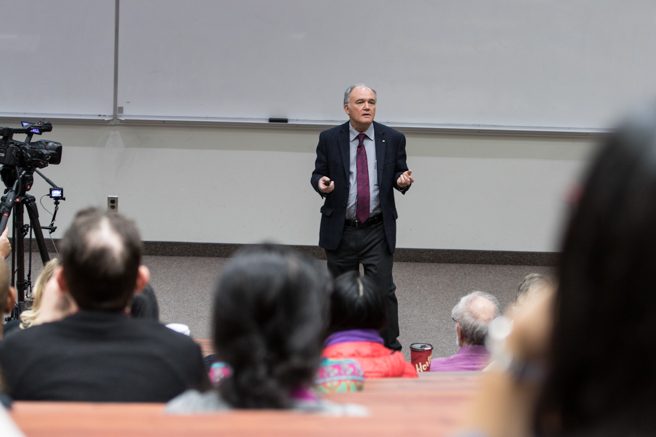Is the answer to the Alzheimer’s disease epidemic computer-modelled molecules? Donald Weaver, senior scientist and director at the Krembil Research Institute in Toronto, believes it very well may be.
The University of Manitoba’s faculty of science hosted Weaver as its second speaker in the Big Data Revolution Speaker Series this past Friday, where he discussed his research on a variety of Alzheimer’s disease treatments.
Weaver focuses his research on creating possible therapies for Alzheimer’s disease with the use of computer-designed compounds.
Donald Weaver, who also practices medicine, believes that our current Alzheimer’s treatments are proof of just how little we know about the diagnosis and treatment of the disease.
“Really, we have nothing. We have a couple of symptomatic drugs,” Weaver said in Friday’s lecture.
“Just as aspirin is not the preferred treatment for strep throat – penicillin, say, would be – we don’t have anything at the penicillin level with Alzheimer’s. We’re still playing around with the aspirins. We’re still playing around with relatively weak symptomatic agents”.
Weaver explained the process his research team is pursuing in creating therapies for Alzheimer’s disease. There are two proteins associated with Alzheimer’s: beta-amyloid and tau. The brain damage that occurs when these proteins misfold is what creates the symptoms of Alzheimer’s disease. Weaver and his team work to create compounds that will slow this misfolding with the help of computer modelling.
The molecules are designed with the ability to bind to receptor sites. The compounds Weaver helps to design are meant to act like a drug, meaning they are able to penetrate the brain barrier, attach to beta-amyloid, and prevent it from interacting with the brain in a degenerative way. Part of the way that beta-amyloid shows that it is about to do serious damage to the brain is through it changing shape. This is the aforementioned misfolding. Its original shape, alpha helix, changes to its more dangerous shape, named beta sheet.
“We have two issues here. We want to prevent it from changing shape from alpha helix to beta sheet,” Weaver said.
“And we want to interfere with its ability to interact with the neuronal membrane.”
Weaver also discussed previous attempts to create a synthetic compound that would prove successful in trials. Perhaps most famous was homotaurine, which Weaver helped license and bring to trial, but failed to properly pass clinical trials. He added that while homotaurine did not pass preliminary trials, it could partially be attributed to the fact that Alzheimer’s disease is so difficult to diagnose, as some people used in the trial may not have even been proper candidates in the first place. Weaver and his team have designed over 1,500 compounds to date.
More recent compounds Weaver has helped design are showing positive results. Weaver discussed a recent drug-like compound that has been shown to bind to both beta-amyloid and tau proteins, along with being able to penetrate the brain barrier. As of now, the experimental compound is going through animal testing and fundraising.
“We now have a lead candidate in pre-clinical optimization, and so we hope to declare a clinical candidate, probably in the first quarter of 2017,” said Weaver.


